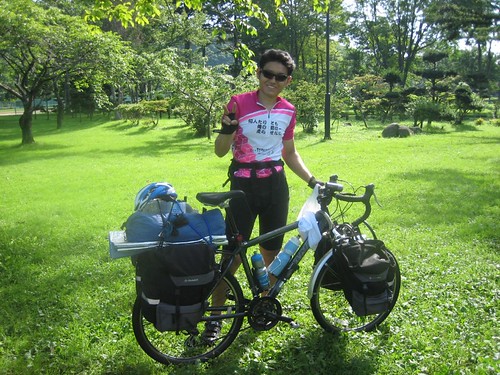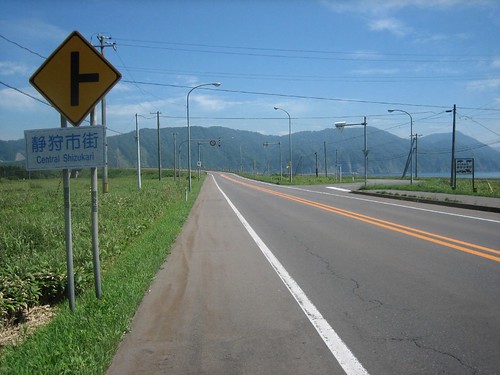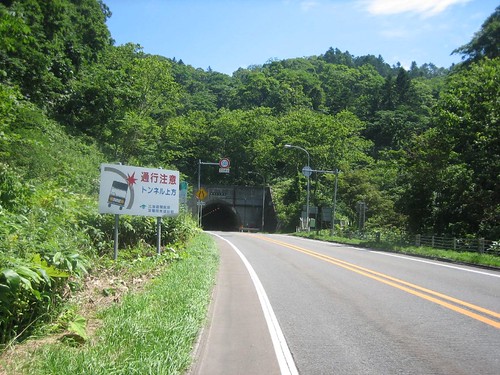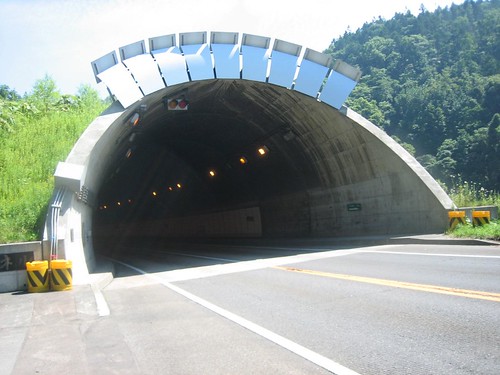I woke up at about 6AM, had breakfast with the family which had given me dinner the night before, played badminton with the daughter of the family and left Oshamanbe Park at about 8:30 AM.
 Before I left I met a university student who happened to be camping next to me. He was in the university cycling club and took a keen interest in me and my trip. He had arrived to Oshamanbe by train from the main Island and was planning to cycle Hokkaido for the next month with his college buddies. I marvelled at the guy's state of the art equipment and wondered how much it had cost him. It seemed like he had spared no expense in preparing himself for his trip. He was surprised that I had gone such a far distance on such a crummy bicycle while carrying a backpack. I told him that when you become 30, you become careless, start doing any kind of endeavor haphazardly and stop caring about whether or not you have the right equipment. He told me that my trip would have been much easier if I had used smooth-surfaced tires rather than the rugged mountain bike tires and I agreed with him. Here is a picture of Mr. Tour-De France. What I learned from him will help me in my next bicycle trip.
Before I left I met a university student who happened to be camping next to me. He was in the university cycling club and took a keen interest in me and my trip. He had arrived to Oshamanbe by train from the main Island and was planning to cycle Hokkaido for the next month with his college buddies. I marvelled at the guy's state of the art equipment and wondered how much it had cost him. It seemed like he had spared no expense in preparing himself for his trip. He was surprised that I had gone such a far distance on such a crummy bicycle while carrying a backpack. I told him that when you become 30, you become careless, start doing any kind of endeavor haphazardly and stop caring about whether or not you have the right equipment. He told me that my trip would have been much easier if I had used smooth-surfaced tires rather than the rugged mountain bike tires and I agreed with him. Here is a picture of Mr. Tour-De France. What I learned from him will help me in my next bicycle trip. The first 10 kilometers after Oshamanbe were easy riding but the pain that I had been feeling in my right knee was starting to become a little more acute and I was not able to ride this section in the time I wanted to. Why did I want to ride the first 10 kilometers so fast? After I had cycled the 10 kilometers I would have to tackle 45 kilometers of mountainous road between Shizukari(静狩) and Abuta (虻田). The greatest challenge would be traversing the Shizukari Mountain Pass (静狩峠) and the Reibungei Mountain Pass (礼文華峠). To the left is a picture of the mountains that I would be cycling through.
The first 10 kilometers after Oshamanbe were easy riding but the pain that I had been feeling in my right knee was starting to become a little more acute and I was not able to ride this section in the time I wanted to. Why did I want to ride the first 10 kilometers so fast? After I had cycled the 10 kilometers I would have to tackle 45 kilometers of mountainous road between Shizukari(静狩) and Abuta (虻田). The greatest challenge would be traversing the Shizukari Mountain Pass (静狩峠) and the Reibungei Mountain Pass (礼文華峠). To the left is a picture of the mountains that I would be cycling through. Surprisingly, once I started ascending the first mountain, my body responded to the challenge and my knee felt fine. Of course, I felt physically tired but I did not feel any other kinds of aches and pains which made the ride rather enjoyable. I had driven this route by car many times but never imagined that I would some day be cycling it.
Surprisingly, once I started ascending the first mountain, my body responded to the challenge and my knee felt fine. Of course, I felt physically tired but I did not feel any other kinds of aches and pains which made the ride rather enjoyable. I had driven this route by car many times but never imagined that I would some day be cycling it.One thing this route had was many tunnels, a total of 7. The longest tunnel was almost 1 kilometer. To the left is a picture of one. Before I went on this trip I looked on the Internet for rules of etiquette on how to go through a tunnel on a bicycle but could not find anything. Going through tunnels can be a little intimidating. First, although there are lights in the tunnel, it is still dark. Second, most tunnels do not have a walk way wide enough to ride a bicycle on with confidence and do not have any kinds of breakdown/bicycle lanes. In other words, at any given part of the tunnel, if the 2 lanes from both directions have cars there is no room for a bicycle on the road. Third, the noise of a vehicle is greatly magnified in a tunnel so that even a mini-car sounds like a bullet train. Lastly, the wind generated from a passing vehicle in a tunnel is quite strong and when you are riding in limited space it can be a little daunting. Anyway, I don't want to scare you too much. Going through a tunnel really isn't that bad. My advice would be to not do anything you are uncomfortable doing. For example, if you are uncomfortable riding your bicycle on the road, don't do it, walk it. Most of the times I rode my bicycle through the tunnels but there was one tunnel that had very heavy traffic and I walked my bicycle half the way. When riding through tunnels cyclists have the following options:

1) Ride your bicycle on the walkway if it is wide enough or you have enough confidence to ride your bicycle on a narrow space while withstanding the wind from the cars.
2) Ride your bicycle on the road.
3) Walk you bicycle on the walkway.
4) Walk your bicycle on the walkway when there are cars and ride your bicycle on the road when there are not cars.
Anyway, my experience riding on the roads of the tunnels was that the cars respected me. However, at one point when the traffic was very heavy I did decide to walk my bicycle and not test the etiquette of the drivers.
 At the Reibungei Mountain Pass, I decided to take a detour, get off the mountain pass, and cycle along the Reibungei coast. I am glad that I did it. Cycling through the Reibungei town felt like riding through a ghost town. Although Reibungei is still inhabited I did not see a single person. I saw no food stores but several beauty salons which made me wonder about the priorities of the Reibungei folk. Of course, there were a few farms; maybe that is where they got their food. Reibungei also had a beautiful beach which was packed with people and tents as the beach also served as a camp site. If anyone is interested in camping for the night on a beach I recommend the Reibungei beach. I think you should keep in mind though, that there are probably very few food stores near by. However, if you would like to get a perm before or after you camp this would be a good site for you.
At the Reibungei Mountain Pass, I decided to take a detour, get off the mountain pass, and cycle along the Reibungei coast. I am glad that I did it. Cycling through the Reibungei town felt like riding through a ghost town. Although Reibungei is still inhabited I did not see a single person. I saw no food stores but several beauty salons which made me wonder about the priorities of the Reibungei folk. Of course, there were a few farms; maybe that is where they got their food. Reibungei also had a beautiful beach which was packed with people and tents as the beach also served as a camp site. If anyone is interested in camping for the night on a beach I recommend the Reibungei beach. I think you should keep in mind though, that there are probably very few food stores near by. However, if you would like to get a perm before or after you camp this would be a good site for you.
I took a rest on the Reibungei coast and took the above picture. It was at this point that I decided to meet up with my wife in a town called Date and go back to Kuriyama that day rather than spend one more day riding. Past Date, I did not think the ride would be so interesting as I would follow the coast for about 50 kilometers through Muroran and Tomokomai, two major industrial cities, and then go about 60 kilometers on rt. 234 inland from Tomakomai to Kuriyama. My body also ached, but the primary reason was that I missed my family and wanted to see them. So, at this beautiful spot where I took the picture, I called my wife and asked her to pick me up in Date. From Date, I would put my bicycle in the car (this is where the expensive bicycle bag came in handy) and we would drive the 120 kilometers back to Kuriyama.
When I was cycling to Date, I realized I had made the right decision as my pace was slow and my back and knee were really starting to hurt. On my way to Date I met someone who was cycling the perimeter of Japan on a 3 speed Mama-chari (Japanese basket bicycle) and felt embarrassed to be complaining about my aches and pains as I had only been cycling for 4 days and on a 21 speed bicycle. At about 3:00 PM I arrived at the Date michi no eki which also featured a "History Village" rekishinomura and waited for my wife to pick me up. To the right is a picture of me at the ending of my trip.
To give one last final reflection on my trip, I was a woefully inexperienced cyclist/camper and had I known what I was doing and been properly prepared I probably could have made it to Kuriyama. Nevertheless, traveling Northern Japan by bicycle enabled me to see that part of the country and interact with the people like I had never done before. I think that a heavily accented, smelly, sweaty and funny-looking guy such as myself must have been an intimidating sight for those who encountered me. Nevertheless, I was treated with respect wherever I went and also received help when I was in need even when I did not ask for it. This trip made me appreciate greatly the relative safety of Japan and also the generosity and thoughtfulness of so many people. Frequently Japan receives a lot of criticism from ex-pats (including me) for its treatment (particularly policy) towards foreigners, but this trip served as a reminder to me about how open-minded and hospitable so many Japanese people are.
No comments:
Post a Comment